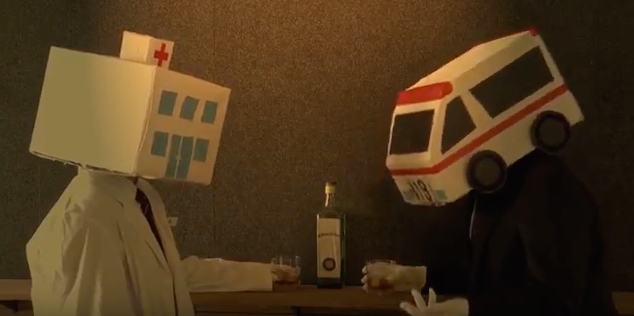Video Origin: Official YouTube Channel of Doshisha Women’s College of Liberal Arts
Translators: Ku-Nung Lin and Eka Jabauri
Japanese script and English translation
救急車: はぁ…
…Sigh
病院: どうした
What’s wrong?
救急車: また今日もいたずら電話だったんっすよ
It’s the prank calls again today.
救急車: 最近多いんっすよね、こういうの
There have been a lot of them lately.
救急車: 昨日もタクシー代わりに呼ばれたし
Yesterday someone called me instead of a taxi again.
救急車: 一昨日なんて「ゴキブリ何とかしてー」って言われたんっすよ
And the day before that, I was even told to “do something about the cockroach.”
救急車: 俺、便利屋じゃないんだけどなぁ
I’m not a handyman service, you know?
テロップ: 助けたいのは命です
What I want to be doing is saving lives.
アナウンサー: 考えよう、119番の使い方
Let’s think carefully about the proper use of 119
About the Video
The video is about advocating the proper use of 119. By showing personified ambulance and hospital, this video tries to communicate the problems that arise with prank calls or calls irrelevant to ambulance’s purpose.
Intended Audience
This video mainly targets those, who are calling 119 irresponsibly, thus trying to discourage such behavior by showing how much trouble it causes. It is also spreading awareness to the general population in hope that social disapproval will help prevent further incidents.
Challenges when translating the video clip, solutions and the rationales
One of the most challenging parts of the process was narrowing down the options for the translation and choosing the one that fit best. We decided to choose the most concise and direct translations to make sure the original meaning wasn’t lost and the translation didn’t come out too long.
There are many colloquial word endings such as よ and なぁ that serves to emphasise the emotion and reinforce the meaning. We wanted to recreate the effect in the English translation, but it was difficult to find the right equivalent since there are no ending particles in English.
Where the most creativity was applied
The most creativity was required at the end, when the caption appears. We thought about making it catchy and memorable, since it’s a slogan, but figured it could take away the seriousness of the message and decided to stick with a more direct translation.
Advice for students who are interested in translating videos
I think it’s important to value maintaining the original meaning, since it’s easy to allow own “voice” to change the tone of the intended message. Of course, creativity is just as important – one should be able to adjust for the differences of the cultures and make sure to relay the message in a way that’s effective for the given audience.
In addition, I think it’s important to keep in mind the length of the translated text. Since videos have a time constraint to each line, if the length of text is much longer than the actual Japanese line, the viewers would have a hard time keeping up with the translation.
Overall experience and thoughts on translation
Eka: Translation is quite a fun process – it makes you think about the nuances of the meaning of each word while paying attention to the overall flow and structure of the narrative. It also makes you think about how cultural differences can affect the way in which the message is relayed and the angle the specific social issue is portrayed in.
The video I worked on was quite short but it was enough to make me intrigued – I’d definitely like to try translating again – and not just videos, but different mediums as well.
Ku-Nung: It was definitely a fun and enjoyable experience. I learnt a lot of new things in both Japanese and English in the translation process, as well as Japanese culture. Translation, I learnt, was not only about rewriting the text in a different language, but also writing it for an audience of different culture.



